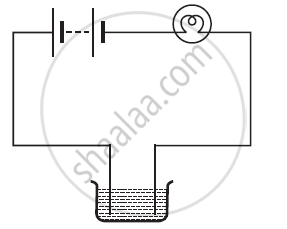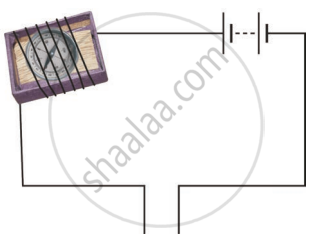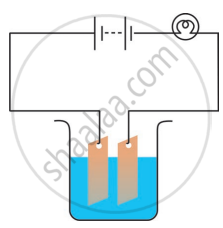Advertisements
Advertisements
प्रश्न
Most liquids that conduct electricity are solutions of ________, _______ and ________.
उत्तर
Most liquids that conduct electricity are solutions of acids, bases and salts.
Explanation:
Because these substances dissociate into ions when water dissolves, the free-moving ions allow electric current to pass through the liquid, making it a good conductor of electricity. This property is commonly observed in hydrochloric acid, sodium hydroxide, and sodium chloride.
APPEARS IN
संबंधित प्रश्न
The bulb does not glow in the setup shown in figure list the possible reasons. Explain your answer.

A tester is used to check the conduction of electricity through two liquids, labelled A and B. It is found that the bulb of the tester glows brightly for liquid A while it glows very dimly for liquid B. You would conclude that ______.
Does pure water conduct electricity? If not, what can we do to make it conducting?
In case of a fire, before the firemen use the water hoses, they shut off the main electrical supply for the area. Explain why they do this.
A child staying in a coastal region tests the drinking water and also the seawater with his tester. He finds that the compass needle deflects more in the case of seawater. Can you explain the reason?
Is it safe for the electrician to carry out electrical repairs outdoors during heavy downpour? Explain.
Paheli had heard that rainwater is as good as distilled water. So, she collected some rain water in a clean glass tumbler and tested it using a tester. To her surprise, she found that the compass needle showed deflection. What could be the reasons?
Which one of the following solutions will not conduct electricity?
Observe the following circuit given in the figure.

Current does not flow in the circuit, if there is a gap between the two wires. Does it indicate that air is a poor conductor of electricity? Does air never conduct electricity? Explain.
Observing that the bulb does not glow in the circuit shown in Fig. (A) Boojho changed the circuit as shown in Fig. (B). He observed deflection in the magnetic compass.
 |
 |
| A | B |
- What does the deflection in magnetic compass indicate?
- Why did the bulb not glow in Fig. (A)?
- What would be the effect of increase in the number of turns in the coil wound around the magnetic compass in Fig. (B)?
- What will be observed if the number of cells are increased in the circuit shown in Fig. (B)?
